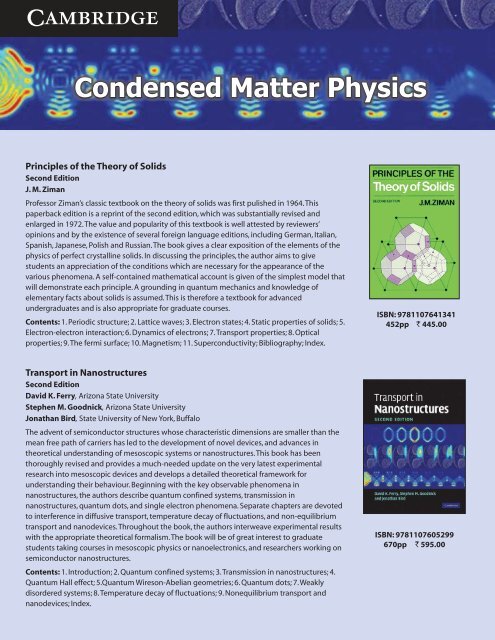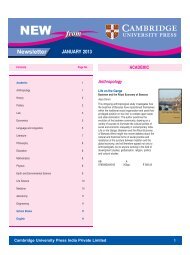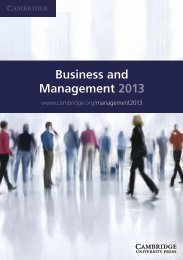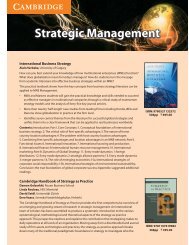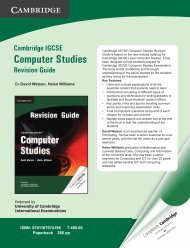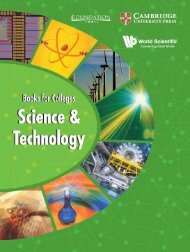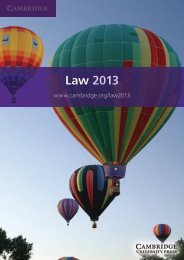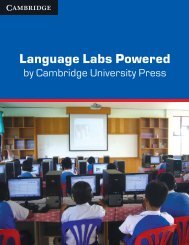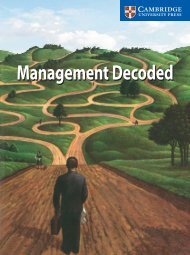Condensed Matter Physics - Cambridge University Press India
Condensed Matter Physics - Cambridge University Press India
Condensed Matter Physics - Cambridge University Press India
Create successful ePaper yourself
Turn your PDF publications into a flip-book with our unique Google optimized e-Paper software.
<strong>Condensed</strong> <strong>Matter</strong> <strong>Physics</strong><br />
Principles of the Theory of Solids<br />
Second Edition<br />
J. M. Ziman<br />
Professor Ziman’s classic textbook on the theory of solids was first pulished in 1964.This<br />
paperback edition is a reprint of the second edition, which was substantially revised and<br />
enlarged in 1972.The value and popularity of this textbook is well attested by reviewers’<br />
opinions and by the existence of several foreign language editions, including German, Italian,<br />
Spanish, Japanese, Polish and Russian.The book gives a clear exposition of the elements of the<br />
physics of perfect crystalline solids. In discussing the principles, the author aims to give<br />
students an appreciation of the conditions which are necessary for the appearance of the<br />
various phenomena. A self-contained mathematical account is given of the simplest model that<br />
will demonstrate each principle. A grounding in quantum mechanics and knowledge of<br />
elementary facts about solids is assumed.This is therefore a textbook for advanced<br />
undergraduates and is also appropriate for graduate courses.<br />
Contents: 1. Periodic structure; 2. Lattice waves; 3. Electron states; 4. Static properties of solids; 5.<br />
Electron-electron interaction; 6. Dynamics of electrons; 7.Transport properties; 8. Optical<br />
properties; 9.The fermi surface; 10. Magnetism; 11. Superconductivity; Bibliography; Index.<br />
ISBN: 9781107641341<br />
452pp ` 445.00<br />
Transport in Nanostructures<br />
Second Edition<br />
David K. Ferry,<br />
Arizona State <strong>University</strong><br />
Stephen M. Goodnick,<br />
Arizona State <strong>University</strong><br />
Jonathan Bird,<br />
State <strong>University</strong> of New York, Buffalo<br />
The advent of semiconductor structures whose characteristic dimensions are smaller than the<br />
mean free path of carriers has led to the development of novel devices, and advances in<br />
theoretical understanding of mesoscopic systems or nanostructures.This book has been<br />
thoroughly revised and provides a much-needed update on the very latest experimental<br />
research into mesoscopic devices and develops a detailed theoretical framework for<br />
understanding their behaviour. Beginning with the key observable phenomena in<br />
nanostructures, the authors describe quantum confined systems, transmission in<br />
nanostructures, quantum dots, and single electron phenomena. Separate chapters are devoted<br />
to interference in diffusive transport, temperature decay of fluctuations, and non-equilibrium<br />
transport and nanodevices.Throughout the book, the authors interweave experimental results<br />
with the appropriate theoretical formalism.The book will be of great interest to graduate<br />
students taking courses in mesoscopic physics or nanoelectronics, and researchers working on<br />
semiconductor nanostructures.<br />
Contents: 1. Introduction; 2. Quantum confined systems; 3.Transmission in nanostructures; 4.<br />
Quantum Hall effect; 5.Quantum Wireson-Abelian geometries; 6. Quantum dots; 7.Weakly<br />
disordered systems; 8.Temperature decay of fluctuations; 9. Nonequilibrium transport and<br />
nanodevices; Index.<br />
ISBN: 9781107605299<br />
670pp ` 595.00
ISBN: 9781107605282<br />
394pp<br />
` 495.00<br />
Electronic Transport in Mesoscopic Systems<br />
Supriyo Datta,<br />
Purdue <strong>University</strong>, <strong>India</strong>na<br />
Recent advances in semiconductor technology have made possible the fabrication of<br />
structures whose dimensions are much smaller than the mean free path of an electron.This<br />
book is the first to give a thorough account of the theory of electronic transport in such<br />
mesoscopic systems. After an initial chapter covering fundamental concepts, the transmission<br />
function formalism is presented, and used to describe three key topics in mesoscopic physics:<br />
the quantum Hall effect; localisation; and double-barrier tunnelling. Other sections include a<br />
discussion of optical analogies to mesoscopic phenomena, and the book concludes with a<br />
description of the non-equilibrium Green's function formalism and its relation to the<br />
transmission formalism. Complete with problems and solutions, the book will be of great<br />
interest to graduate students of mesoscopic physics and nanoelectronic device engineering, as<br />
well as to established researchers in these fields.<br />
Contents: 1. Preliminary concepts; 2. Conductance from transmission; 3.Transmission function,<br />
S-matrix and Green’s functions; 4. Quantum Hall effect; 5. Localisation and fluctuations;<br />
6. Double-barrier tunnelling; 7. Optical analogies; 8. Non-equilibrium Green’s function<br />
formalism.<br />
ISBN: 9780521166843<br />
348pp ` 495.00<br />
Introduction to Nanoelectronics<br />
Science, Nanotechnology, Engineering and Applications<br />
Vladimir V. Mitin,<br />
State <strong>University</strong> of New York, Buffalo<br />
Viatcheslav A. Kochelap,<br />
National Academy of Sciences, Ukraine<br />
Michael A. Stroscio,<br />
<strong>University</strong> of Illinois, Chicago<br />
This textbook is a comprehensive, interdisciplinary account of the technology and science<br />
underpinning nanoelectronics, covering the underlying physics, nanostructures, nanomaterials,<br />
and nanodevices. It provides a unifying framework for the basic ideas needed to understand<br />
the developments in the field. After introducing the recent trends in semiconductor and device<br />
nanotechnologies, as well as novel device concepts, the methods of growth, fabrication and<br />
characterization of materials for nanoelectronics are discussed. Coverage then moves to an<br />
analysis of nanostructures including recently-discovered nanoobjects, and concludes with a<br />
discussion of devices that use a 'simple' scaling-down approach to copy well-known<br />
microelectronic devices, and nanodevices based on new principles that cannot be realized at<br />
the macroscale.With numerous illustrations and homework problems, this textbook is suitable<br />
for advanced undergraduate and graduate students in electrical and electronic engineering,<br />
nanoscience, materials, bioengineering and chemical engineering. Additional resources,<br />
including instructor-only solutions and Java applets, are available from<br />
www.cambridge.org/9780521881722.<br />
Contents: Preface; Notations; 1.Towards the nanoscale; 2. Particles and waves; 3.Wave<br />
mechanics; 4. Materials for nanoelectronics; 5. Growth, fabrication, and measurement<br />
techniques for nanostructures; 6. Electron transport in semiconductors and nanostructures;<br />
7. Electrons in traditional low-dimensional structures; 8. Nanostructure devices; Index.
Electrical Transport in Nanoscale Systems<br />
Massimiliano Di Ventra,<br />
<strong>University</strong> of California, San Diego<br />
In recent years there has been a huge increase in the research and development of nanoscale<br />
science and technology. Central to the understanding of the properties of nanoscale structures<br />
is the modeling of electronic conduction through these systems.This graduate textbook<br />
provides an in-depth description of the transport phenomena relevant to systems of nanoscale<br />
dimensions. In this textbook the different theoretical approaches are critically discussed, with<br />
emphasis on their basic assumptions and approximations.The book also covers information<br />
content in the measurement of currents, the role of initial conditions in establishing a steady<br />
state, and the modern use of density-functional theory.Topics are introduced by simple<br />
physical arguments, with particular attention to the non-equilibrium statistical nature of<br />
electrical conduction, and followed by a detailed formal derivation.This textbook is ideal for<br />
graduate students in physics, chemistry, and electrical engineering.<br />
Contents: Preface; 1. A primer on electron transport; 2. Drude, Kubo, and Boltzmann<br />
approaches; 3. Landauer approach; 4. Non-equilibrium Green’s function formalism; 5. Noise; 6.<br />
Electron-ion interaction; 7.The micro-canonical picture of transport; 8. Hydrodynamics of the<br />
electron liquid; Appendices; References; Index.<br />
ISBN: 9780521140317<br />
496pp ` 795.00<br />
<strong>Condensed</strong> <strong>Matter</strong> Field Theory<br />
Alexander Altland,<br />
Universität zu Köln<br />
Ben Simons,<br />
<strong>University</strong> of <strong>Cambridge</strong><br />
Over the past few decades, in concert with ground-breaking experimental advances,<br />
condensed matter theory has drawn increasingly from the language of low-energy quantum<br />
field theory.This primer is aimed at elevating graduate students of condensed matter theory to<br />
a level where they can engage in independent research. It emphasizes the development of<br />
modern methods of classical and quantum field theory with applications oriented around<br />
condensed matter physics.Topics covered include second quantization, path and functional<br />
field integration, mean-field theory and collective phenomena, the renormalization group, and<br />
topology. Conceptual aspects and formal methodology are emphasized, but the discussion is<br />
rooted firmly in practical experimental application. As well as routine exercises, the text<br />
includes extended and challenging problems, with fully worked solutions, designed to provide<br />
a bridge between formal manipulations and research-oriented thinking.This book will<br />
complement graduate level courses on theoretical quantum condensed matter physics.<br />
Contents: 1. From particles to fields; 2. Second quantisation; 3. Feynman path integral; 4.<br />
Functional field integral; 5. Perturbation theory; 6. Broken symmetry and collective phenomena;<br />
7. Response functions; 8.The renormalization group; 9.Topology; Bibliography.<br />
ISBN: 9780521736442<br />
636pp ` 545.00<br />
Principles of <strong>Condensed</strong> <strong>Matter</strong> <strong>Physics</strong><br />
P. M. Chaikin,<br />
Princeton <strong>University</strong>, New Jersey<br />
T. C. Lubensky,<br />
<strong>University</strong> of Pennsylvania<br />
Overview of the physics of condensed matter systems, written in a clear, pedagogic style with<br />
extensive examples of real-world systems. Serves as a course text as well as an essential<br />
reference for students and researchers.<br />
Contents: Preface; 1. Overview; 2. Structure and scattering; 3.Thermodynamics and statistical<br />
mechanics; 4. Mean-field theory; 5. Field theories, critical phenomena, and the renormalization<br />
group; 6. Generalized elasticity; 7. Dynamics: correlation and response; 8. Hydrodynamics; 9.<br />
Topological defects; 10.Walls, kinks and solitons; Glossary; Index.<br />
ISBN: 9788175960251<br />
699pp ` 495.00
ISBN: 9780521898638<br />
578pp ` 2950.00<br />
Ab Initio Molecular Dynamics<br />
Basic Theory and Advanced Methods<br />
Dominik Marx,<br />
Ruhr-Universität, Bochum, Germany<br />
Jürg Hutter,<br />
Universität Zürich<br />
Ab initio molecular dynamics revolutionized the field of realistic computer simulation of<br />
complex molecular systems and processes, including chemical reactions, by unifying molecular<br />
dynamics and electronic structure theory.This book provides the first coherent presentation of<br />
this rapidly growing field, covering a vast range of methods and their applications, from basic<br />
theory to advanced methods.<br />
This fascinating text for graduate students and researchers contains systematic derivations of<br />
various ab initio molecular dynamics techniques to enable readers to understand and assess<br />
the merits and drawbacks of commonly used methods. It also discusses the special features of<br />
the widely used Car-Parrinello approach, correcting various misconceptions currently found in<br />
research literature.<br />
The book contains pseudo-code and program layout for typical plane wave electronic structure<br />
codes, allowing newcomers to the field to understand commonly used program packages, and<br />
enabling developers to improve and add features in their code.<br />
Contents: Part I. Basic Techniques: 1. Setting the stage: why ab initio molecular dynamics; 2.<br />
Getting started: unifying Md and electronic structure; 3. Implementation: using the plane wave<br />
basis set; 4. Atoms with plane waves: accurate pseudopotentials; Part II. Advanced Techniques:<br />
5. Beyond standard ab initio molecular dynamics; 6. Beyond norm-conserving pseudopotentials;<br />
7. Computing properties; 8. Parallel computing; Part III. Applications: 9. From materials to<br />
biomolecules; 10. Properties from ab initio simulations; 11. Outlook; References; Index.<br />
* Prices are subject to change without notice.


